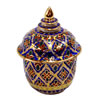Benjarong Ceramics
The Benjarong is a traditional form of Thai porcelain. The style of multi-colored enamels on a white porcelain base came from Ming dynasty China. The name “Benjarong” was derived from Bali and Sanskrit words Benja and Rong, meaning literally “Five Colors”. “Five Colors” really means “many colors” because the hand-painted pieces are usually decorated in three, five, eight colors, or even more. In the 13th – 18th century, Benjarong porcelain was exclusively made for the royal court. Later its use extended to aristocrats and wealthy merchants; today people of all nationalities use Benjarong for formal ware. The designs on the earliest Benjarong used a limited number of colors mostly for religions subjects but eventually a new design style grew up known as “Lai Nam Thong” which used gold as its distinctive colors. In the reign of King Rama II (1809-1851) Lai Nam Thong wares with gorgeous gold accents were very popular. Today, the original Benjarong porcelain wares have display at the Thai National Museum in Bangkok. |
Buy Benjarong on our secure server
Benjarong porcelain originates in China, and came to Thailand as part of the dowry of Chinese princesses. Eventually, in the early 1800s, during the reign of King Rama II, Thai artisans began producing Benjarong for the Royal Court with a slight variation, which they named Lai Nam Thong (gold washed design) whereupon bright, liquid gold was used to outline the admirable patterns that would grace the Benjarong porcelain pieces.
These pieces will shine forever and require only a damp cloth to wipe away dust.
Note: Benjarong is not dishwasher safe. If cleaning is needed, use a gentle dish soap and soft sponge. Never use abrasive pads or scouring agents.
Asian Pottery Has A Lot To Offer And Thai Benjarong Is One Of The Spectacular Highlights Of Pottery From Asia. Handmade Ceramic Pottery Is Painted With Artistic And Serene Designs. The Painting On Benjarong Pottery From Thailand Is Also Done By Hand. Read More About The History And Tradition Of Thai Bencharong Ceramic Pottery
More information for the Benjarong Magazine






































